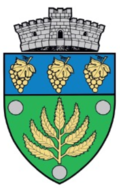Mica (Mureș)
|
Mica Michelsdorf Mikefalva |
||||
|
||||
| Basic data | ||||
|---|---|---|---|---|
| State : |
|
|||
| Historical region : | Transylvania | |||
| Circle : | Mureș | |||
| Coordinates : | 46 ° 22 ' N , 24 ° 25' E | |||
| Time zone : | EET ( UTC +2) | |||
| Height : | 308 m | |||
| Area : | 63.90 km² | |||
| Residents : | 4,539 (October 20, 2011) | |||
| Population density : | 71 inhabitants per km² | |||
| Postal code : | 547400 | |||
| Telephone code : | (+40) 02 65 | |||
| License plate : | MS | |||
| Structure and administration (as of 2016) | ||||
| Community type : | local community | |||
| Structure : | Mica, Abuș , Căpâlna de Sus , Ceuaș , Deaj , Hărănglab , Șomoștelnic | |||
| Mayor : | Szekely Ladislau ( UDMR ) | |||
| Postal address : | Str. Principală, no. 56 loc. Mica, jud. Mureș, RO-547400 |
|||
| Website : | ||||
Mica ( German Michelsdorf , Hungarian Mikefalva or Középfalu ) is a municipality in the Mureș District , in the Transylvania region in Romania .
Geographical location
The municipality of Mica is located in the Kokel Valley (Podișul Târnavelor) in the south of the Mureș County. On the river Târnava Mică (Little Kokel) , the county road (Drum județean) DJ 142 and the railway line Blaj – Târnăveni – Praid is the place Mica ten kilometers east of the city of Târnăveni (Saint Martin) and 26 kilometers southwest of the district capital Târgu Mureş (Neumarkt am Mieresch) away.
The six incorporated villages are between one and nine kilometers from the community center.
history
The place Mica was first mentioned in 1332. The namesake of the place was the Weißenburg Count Mika , who founded a new village in the area of the former place Căpâlna de Sus (Kappeln) . The incorporated villages were first mentioned in a document as follows: Abuș (Abuss) was 1357, Căpâlna de Sus was 1332, Ceuaș (Grubendorf) and Deaj (Desendorf) 1301, Hărănglab (bell village ) was 1361 and Șomoștelnic (Futak) 1339.
In the Kingdom of Hungary , today's community belonged mostly the chair district Dicsőszentmárton ( Târnăveni ) only the unincorporated village Şomoştelnic the chair district Radnót ( Iernut ) in the County Small Kokelburg , then the historic county Târnava-Mică and from 1950 to today's county Mures on.
population
The population of the municipality developed as follows:
| census | Ethnic composition | ||||
|---|---|---|---|---|---|
| year | population | Romanians | Hungary | German | other |
| 1850 | 3,972 | 1,616 | 2,070 | - | 286 |
| 1930 | 4,858 | 1,722 | 2,753 | 6th | 377 |
| 1966 | 5,200 | 1,598 | 3.141 | 3 | 458 |
| 2002 | 4,701 | 1,036 | 2,591 | 2 | 1,072 |
| 2011 | 4,539 | 787 | 2,378 | 2 | 1,372 (Roma 1,197) |
The highest number of inhabitants has been registered in the area of today's municipality since 1850 and that of the Magyars in 1966. The highest population of Romanians (2,016) was determined in 1941, that of Roma in 2011 and that of Romanian Germans (36) in 1880.
Attractions
- In the community center the Keresztes-Eperjesi mansion , built in the 18th century, today's town hall, is a listed building.
- In the incorporated village of Abuş, the Apor manor , built in 1775, renovated in 1830, and the wooden church Sfinții Arhangheli , built in the 18th century, are listed buildings. Furthermore, there are remains of a castle on the area of the incorporated village, called Cetatea lui Almoș or Almás by the locals , which has not yet been assigned to an era.
- In the incorporated village Deaj (Hungarian Désfalva ) a wooden church, the manor house Pap , built in 1796, the Unitarian church , built in 1834, and the manor house Pataki built in 1910 are listed.
personality
- Vasile Cristea (1906–2000), was a Romanian Greek Catholic bishop , apostolic visitor and titular bishop of Lebedus .
Web links
Individual evidence
- ↑ 2011 census in Romania ( MS Excel ; 1.3 MB)
- ↑ Arcanum Kézikönyvtár: Historical-administrative book of place names of Transylvania, Banat and Partium. Retrieved February 3, 2018 (Hungarian).
- ↑ Information on the website of the municipality of Mica , accessed on March 10, 2018 (Romanian).
- ↑ Szentgyörgyi Sándor: Désfalva. Video on YouTube , October 7, 2008, accessed March 10, 2018 (Hungarian).
- ↑ Szentgyörgyi Sándor: Harangláb. Video on YouTube , October 7, 2008, accessed March 10, 2018 (Hungarian).
- ↑ Heinz Heltmann, Gustav Servatius (Ed.): Travel Guide Siebenbürgen . Kraft, Würzburg 1993, ISBN 3-8083-2019-2 , p. 517 .
- ↑ Censuses 1850–2002, last updated November 2, 2008 (PDF; 1 MB; Hungarian)
- ↑ a b c List of historical monuments of the Romanian Ministry of Culture, updated 2015 (PDF; 12.7 MB; Romanian)
- ↑ Institute Of Archeology - Abuș accessed on March 10, 2018 (Romanian)
- ↑ Information on the Unitarian Church in Deaj at biserici.org, accessed on March 10, 2018 (Romanian)
- ^ Bishop Vasile Cristea, AA at catholic- hierarchy.org.Retrieved March 9, 2018








